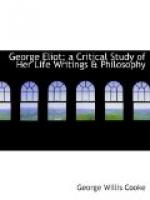She was first sent, with her brother Isaac, to a free school in the village of Griff. Among her mates was William Jacques, the original of Bob Jakins in The Mill on the Floss. When seven years old she went to a girls’ school at Nuneaton. Her schoolmates describe her as being then a “quiet, reserved girl, with strongly lined, almost masculine features, and a profusion of light hair worn in curls round her head.” The abundance of her curling hair caused her much trouble, and she once cut it off, as Maggie Tulliver did, because it would not “lie straight.” “One of her school-fellows,” we are told, “recalls that the first time she sat down to the piano she astonished her companions by the knowledge of music she had already acquired. She mastered her lessons with an ease which excited wonder. She read with avidity. She joined very rarely in the sports of her companions, and her diffidence and shrinking sensibility prevented her from forming any close friendship among her school-fellows. When she stood up in the class, her features, heavy in repose, were lighted by eager excitement, which found further vent in nervous movements of her hands. At this school Marian was well taught in English, with drawing, music, and some little French.”
Leaving this school at the age of twelve, she went to that of the Misses Franklin in Coventry, a large town a few miles distant. To the careful training received there she was much indebted, and in after years often spoke of it with the heartiest appreciation. One of her friends, Edith Simcox, has given an account of this school and of Marian’s studies there. “Almost on the outskirts of the old town of Coventry, towards the railway station, the house may still be seen, itself an old-fashioned five-windowed, Queen Anne sort of dwelling, with a shell-shaped cornice over the door, with an old timbered cottage facing it, and near adjoining a quaint brick and timber building, with an oriel window thrown out upon oak pillars. Between forty and fifty years ago, Methodist ladies kept the school, and the name of ‘little mamma,’ given by her school-fellows, is a proof that already something was to be seen of the maternal air which characterized her in later years, and perhaps more especially in intercourse with her own sex. Prayer meetings were in vogue among the girls, following the example of their elders; and while taking, no doubt, a leading part in them, she used to suffer much self-reproach about her coldness and inability to be carried away with the same enthusiasm as others. At the same time, nothing was farther from her nature than any sceptical inclination, and she used to pounce with avidity upon any approach to argumentative theology within her reach, carrying Paley’s Evidences up to her bedroom, and devouring it as she lay upon the floor alone.”
During the three years Marian attended this school she held aloof from the other pupils, was grave and womanly in her deportment. She acquired Miss Rebecca Franklin’s slow and precise method of speaking, and to her diligent training owed her life-long habit of giving a finished completeness to all her sentences. It seems that her imagination was alive at this time, and being slowly cultivated. She was in the habit of scribbling verses in her books and elsewhere.




